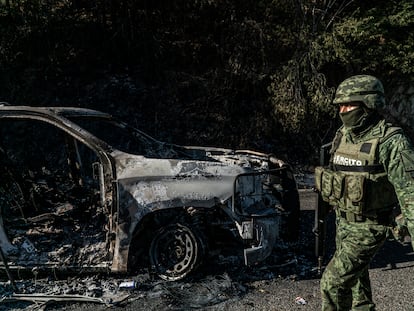Human experiments in Tijuana and Mexicali: How cartels are testing fentanyl on drug addicts
Organized crime syndicates use vulnerable people in border cities to calculate the dosages of the opioid that they traffic to the United States


Tijuana and Mexicali have become the epicenter of fentanyl consumption in Mexico, according to Victor Clark, director of the Binational Center for Human Rights and professor of Latin American Studies at the University of San Diego in California. The two Mexican border cities have provided the perfect laboratory for the cartels to calculate the exact dosage a person can take, non-lethally, while reducing their own costs and taking advantage of the huge problem of drug addiction on the U.S.-Mexico border. “The cartels introduced the new product into the local market to generate demand,” says Clark. To do so, they distributed the drug mixed with other substances such as cocaine, methamphetamine, heroin, and crystal meth, until a certain tolerance to the fentanyl content was established.
“They have created a local market of people who are already consuming fentanyl directly,” adds Clark. A few weeks ago, the U.S. State Department released a report claiming that criminal organizations are experimenting on humans to measure the potency of the drug they sell. “The cartel is trying to produce the most powerful fentanyl and sell it in the U.S. at the lowest price,” the report noted. The U.S. Drug Enforcement Agency (DEA) estimates that a three-gram dose of the synthetic drug can prove deadly to the average person.
In just a few years, fentanyl has gone from being largely unknown to an epidemic that has strained bilateral relationship between Mexico and the United States. The synthetic drug is more potent, cheaper, and more difficult for authorities to detect, which has turned it into a lucrative business worth billions of dollars and, in turn, is responsible for a public health crisis that kills tens of thousands of Americans every year, according to official data.
While the latest crusade against drugs is being waged in offices between a country of “consumers” and a country of “producers,” the evidence points to an increase of fentanyl use in Mexico, although the country has no public policy to address the situation and has not carried out a national addiction survey in years. In the meantime, researchers like Clark have turned to field work to get an approximation of the scale of fentanyl consumption.
According to Clark, Tijuana had a population of “around half a million drug addicts” in 2018. However, five years later, the analyst says that figure has risen. In the absence of official statistics, organizations move blindly and only have access to records provided by rehabilitation centers and statistics on the number of overdose deaths. “The rehab centers say that with the advent of the new drug, the number has skyrocketed,” Clark notes.
Over the last decade, fentanyl was introduced into the market as an adulterate in other opioids, causing users to become addicted to fentanyl without realizing they were taking it. As Clark points out: “Many addicts consumed heroin and crystal meth without knowing that it was already mixed with fentanyl, they just said it was very potent.” That was the strategy the cartels developed to generate demand in the market. “At first what they did was mix it with heroin, cocaine, methamphetamine or crystal meth,” Clark explains.
The absence of official statistics on fentanyl use in Mexico also means that it is impossible to put a number on how many people die from overdoses. The only local gauges are civil society organizations that work with addicts, and hospital reports. “The only data we have available is provided by the Red Cross, which says it treats 20 people a month for overdoses,” Clark says.
On April 14, the U.S. Department of Justice indicted three of Joaquín “El Chapo” Guzmán’s sons — Iván Archivaldo Guzmán Salazar, Jesús Alfredo Guzmán Salazar and Ovidio Guzmán López — along with 25 other members of Los Chapitos, a continuation faction of the Sinaloa Cartel, for allegedly trafficking fentanyl from Mexico into the United States. The indictment describes the case of a woman who was given three doses of the opiate in Mexico to calculate the dosage of the chemicals in the drug, and who subsequently died of an overdose. Other addicts were also subjected to these tests. “One of them died from an overdose,” the document states. However, the drugs they consumed were still trafficked to the United States.
Clark says that the increase in fentanyl use has been worsening over the past five years. In 2019, researcher Clara Fleiz of the National Institute of Psychiatry in Mexico City warned of the dangers of not acting to address the fentanyl problem in the country during an interview with EL PAÍS. “We could be on the verge of a crisis. The illicit fentanyl market has reached the border and is already affecting injecting drug users, the most vulnerable populations,” she said. According to Fleiz, the substance arrived in Tijuana via users deported from the United States. The expert adds that fentanyl use has increased in border areas, but authorities do not have statistics on the number of affected people.
A week ago, Mexico’s Chamber of Deputies approved an initiative promoted by President Andrés Manuel López Obrador to punish anyone trafficking fentanyl precursor chemicals into the country with up to 15 years in jail. So far, however, the growing public health crisis remains on the sidelines. “The authorities were late to respond, at least in Tijuana. If significant resources are not invested in prevention, education and, above all, rehabilitation, I believe that fentanyl is going to overwhelm us in all parts of the country in the coming years,” says Clark.
Sign up for our weekly newsletter to get more English-language news coverage from EL PAÍS USA Edition
Tu suscripción se está usando en otro dispositivo
¿Quieres añadir otro usuario a tu suscripción?
Si continúas leyendo en este dispositivo, no se podrá leer en el otro.
FlechaTu suscripción se está usando en otro dispositivo y solo puedes acceder a EL PAÍS desde un dispositivo a la vez.
Si quieres compartir tu cuenta, cambia tu suscripción a la modalidad Premium, así podrás añadir otro usuario. Cada uno accederá con su propia cuenta de email, lo que os permitirá personalizar vuestra experiencia en EL PAÍS.
¿Tienes una suscripción de empresa? Accede aquí para contratar más cuentas.
En el caso de no saber quién está usando tu cuenta, te recomendamos cambiar tu contraseña aquí.
Si decides continuar compartiendo tu cuenta, este mensaje se mostrará en tu dispositivo y en el de la otra persona que está usando tu cuenta de forma indefinida, afectando a tu experiencia de lectura. Puedes consultar aquí los términos y condiciones de la suscripción digital.
More information
Archived In
Últimas noticias
Trump claims peace in Ukraine is near, but Moscow suggests otherwise
A survivor’s account of the Interoceanic Train accident: ‘We were scared because of the speed on the curve’
The Interoceanic Train, the Mexican alternative to the Panama Canal
What is known about the Interoceanic Train derailment in Oaxaca
Most viewed
- Oona Chaplin: ‘I told James Cameron that I was living in a treehouse and starting a permaculture project with a friend’
- Reinhard Genzel, Nobel laureate in physics: ‘One-minute videos will never give you the truth’
- Why the price of coffee has skyrocketed: from Brazilian plantations to specialty coffee houses
- Pablo Escobar’s hippos: A serious environmental problem, 40 years on
- Chevy Chase, the beloved comedian who was a monster off camera: ‘Not everyone hated him, just the people who’ve worked with him’










































